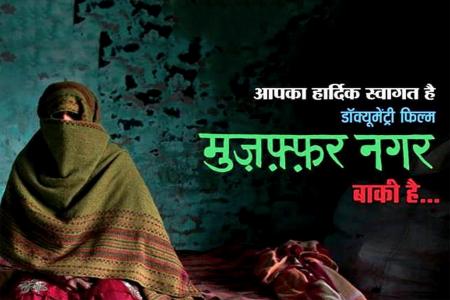On August 25, I walked down to Spaces, Sadanand Menon’s home in Besant Nagar, Chennai for the screening of Muzaffarnagar Baqi Hai (Muzaffarnagar remains), a documentary by Nakul Singh Sawhney on the Muzaffarnagar riots that occurred in September 2013. There were about a hundred people there and at least a score of police personnel with about 3 vans. The screening, we were told, was posing a threat to public order, so it should not occur. In a phone call I received earlier that day, I was told that the police had said that they could not protect the audience. The gathered people held a public discussion in Tamil and it was decided that Mr. Menon’s home should be protected and the screening would be moved elsewhere. A few people suggested we should split the group up and screen the documentary in our private homes, where we would possibly not be causing a threat to public order.
 Public order is a dubious term in India, especially in a country where disorder rules on a quotidian basis. From traffic to public trash, disorder is the name of the game and how a screening would affect public order, was beyond the understanding of several members of the audience. The film screening was finally shifted to the Goethe Institute at the kindly suggestion of Mr. Helmut Schippert, Director of the institute. He at least was not deterred by empty threats.
Public order is a dubious term in India, especially in a country where disorder rules on a quotidian basis. From traffic to public trash, disorder is the name of the game and how a screening would affect public order, was beyond the understanding of several members of the audience. The film screening was finally shifted to the Goethe Institute at the kindly suggestion of Mr. Helmut Schippert, Director of the institute. He at least was not deterred by empty threats.
The audience moved half way across Chennai to view the documentary after a rudimentary protest at Elliot’s Beach. On August 25, 50 cities across 22 Indian States had groups dedicated to screening the film. Organized by a group called Cinema of Resistance, the multiple parallel screenings were organized in reaction to the disruption of the original screening of the documentary in late July at Kirori Mal College at the University of Delhi by members of the Akhil Bharatiya Vidyarthi Parishad (ABVP), the student wing of the ruling Bharatiya Janata Party. On August 25, an estimated 7000 people across India were able to watch this documentary.
Essentially, what transpired in Besant Nagar was a police force shutting down a lawful screening at the behest of higher bosses. No one from the right-wing BJP and its affiliate organizations was present and there was no suggestion of a protest-war breaking out between audience members and those that did not want the film screened. In fact, Tamil Nadu is one of the few States where the BJP has been extremely hard pressed to make its political presence felt. So the puzzle was, where were the supporters and exactly why did the police feel that a screening was a threat to public order?
Muzaffarnagar Baqi Hai is an interesting documentary that tracks the politics of Muzaffarnagar district in Uttar Pradesh. It tells a powerful narrative of a party, the BJP, trying to create a rural voter base by resorting to inflammatory speeches and organized acts of violence. The film pushes the point, also reflected in the excellent work of Pradeep Chhibber, that parties create social cleavages and not the other way around in India.
The 138 minute long documentary can be a bit tedious in parts for those who have actively followed Anand Patwardhan’s work on the Babri Masjid demolition of 1992 called Raam ke Naam (In the Name of God) and Rakesh Sharma’s The Final Solution on the Gujarat riots of 2002. Both documentaries tell a similar narrative – how a lesser-known party (in both cases the BJP) creates a voter base by resorting to the politicization of the most primordial identity differences that can exist in Indian society – caste and religion.
In that sense Muzaffarnagar Baqi Hai adds itself to this list of documentaries, which serve more as a historical record in a time when competing historical narratives and active historical rewriting are beginning to obscure facts surrounding such communal incidents that have occurred in India in recent history. In the documentary, Muslims of Muzaffarnagar now relegated to refugee camps actively give testimonies. They name culprits, they ask for justice, they talk about how they had to flee from sword-bearing Hindu jats, they talk in metaphors about sexual violence (about 100 women were raped in the riots says the film). The victims of the riots also offer astute readings of the local political situation. Almost all agreed that the polarization of the Hindu and Muslim communities is engineered by political parties and the riots were organized. This testimony came from people who had not read Paul Brass’s work (The Production of Hindu Muslim Violence in India).
The documentary’s background is local state machinery that cannot act in time to protect citizens, campaigning for the 2014 elections in India and the strategies used by politicians to garner votes. From the film, it seems as if the most effective strategy for a politician is to forget about development (or offer it as a sop) but to actively talk about personal identity. This it seems is what makes or breaks political careers. And how does one go about establishing an identity-based popularity for a party. It is simple really, says Sawhney’s film. Start a riot or two!
The film is a critique of a political class that actively uses identity to get into power, but actively also uses identity to deliver public goods – the most basic one being security of its citizens.
One of the most astute comments in the film comes for a riot-affected person who talks about the BJP hijacked several local platforms including that of the Bharatiya Kisan Union and the local khap (non-constitutional village assembly). Khaps in India are notorious for extremely regressive readings of Indian culture. They police women’s dress, marriage and have often sanctioned punishments outside the bounds of the constitutional legal system. The victim suggests that the BJP entered the khap space by mimicking the language of khaps. So if the khap members think that people of the same gotra cannot marry, the local BJP leader supported it. In return, the khaps were expected to garner political support for the BJP.
The only positive aspect in the film is that it also tracks a group that is progressive and tries to, in the film, shift the local district discourse from identity to developmental issues. They go house to house to reason with people about inflation, development, women’s safety, etc, but as the film shows, are often met with local resistance.
The film is definitely an important primer if someone is to understand contemporary politics in India. It focuses on spaces which are not seen internationally and not worthy of being gloated about on the global scene. It focuses on spaces where elections are won and lost and the trauma that people face as local politicians ascend.
Vasundhara Sirnate is the Chief Coordinator of Research at The Hindu Centre for Politics and Public Policy. She is also a Non-Resident Fellow at the Atlantic Council, Washington DC
